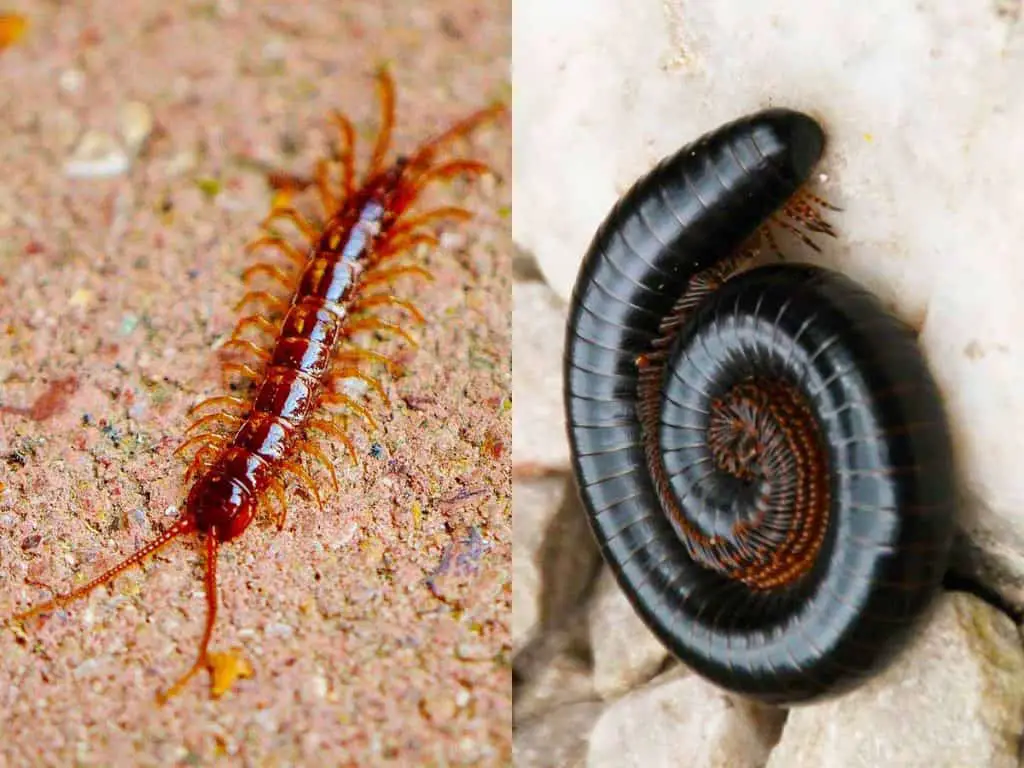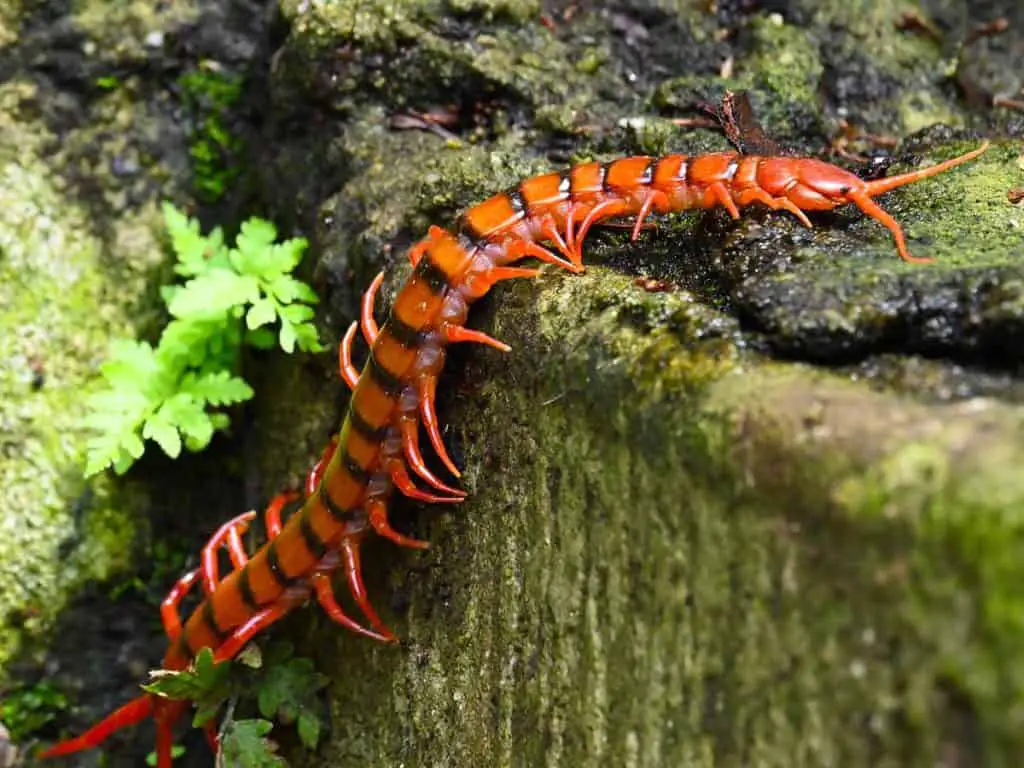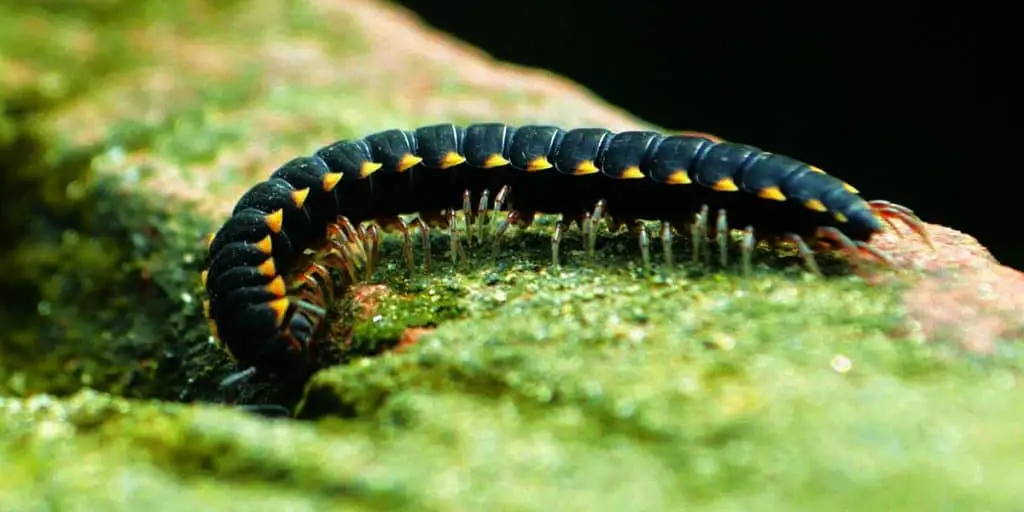Centipede vs. Millepede (3 Differences Explained!)
What are these creatures, and how are centipedes and millipedes different?
The centipedes’ body is relatively flat, with one pair of legs per segment – one on each side. Millipedes have a more rounded body with two pairs of legs per body segment – one pair on either side under the body. Further, centipedes are poisonous and millipedes aren’t, which, by nature, explains their different diets.
Despite those fundamental differences, they share some similarities – how are centipedes and millipedes alike?
Both centipedes and millipedes are arthropods – invertebrate animals with jointed legs on segmented bodies. They also have antennae, breathe through pore-like holes along the body’s length, and poor vision.
They prefer to live under mulch, compost, stones, and leaf piles but will occasionally make their way into your home in such places as the basements, crawl spaces, bathrooms, or potted plants.
However, their similarities end there.
Read on to learn more about the differences between millipedes and centipedes.

1. It’s All About the Legs
Both centipedes and millipedes have segmented bodies that line up to create one long body structure.
The largest centipede species in the world reaches 10 inches (30 cm), found in Central and South America (source). The longest millipede can reach 15 inches (38 cm) (source).
One way to tell the difference between a centipede and a millipede is where the legs attach to their body.
Millipede legs are directly under the body, with two pairs of legs per segment. When looking from top-down, their legs are harder to see as a result. Such a high number of legs in alignment also cause them to move more slowly than their centipede counterpart.
On the contrary, centipedes have only one pair of legs per segment, with one growing out of either side of their body. This physical attribute makes them visibly different from millipedes, allowing them to move much quicker by comparison – either while hunting or escaping a threat.
How many legs do centipedes have?
The term “centi” means 100 in Latin, but centipedes’ number of legs varies between 30 (15 pairs) and 354 (177 pairs). The wide range is not surprising when considering the estimated 8,000 species of centipedes living in various geographical extremes – from the cold Arctic to the humid rainforests and arid deserts.
How many legs do millipedes have?
Although the prefix “milli” means 1,000 in Latin, millipedes – covering approximately 7,000 species – actually have between 34 (17 pairs) and 400 legs (200 pairs). The highest number recorded is 750 legs (375 pairs), which is more than any other animal on the planet. Younger and shorter millipedes naturally have fewer legs.
2. What Do They Eat?
The diets of centipedes and millipedes are polar opposites.
Millipedes scavenge for their food, mostly burrowing into the dirt to dine on leaf litter and decomposing plants. Their front set of legs provide them the power to act like a bulldozer in search of food.
Millipedes prefer dead and decomposing plants, so they are not a threat to your gardens. As nature’s recyclers, they are beneficial to the environment by breaking down decaying organic matters.
On the other hand, centipedes are carnivores that sting their prey with venom before feasting.
Centipedes capture their prey using a lassoing technique – by jumping on the target, scoop it up with all their legs, and sting it with the front two legs near their head, which contain venom.
They hunt at night, and the soft-bodied insects that make up their diet include:
- Spiders
- Worms
- Cockroaches
- Moths
- Crickets
- Bed bugs
- Silverfish
- Termites
- Other centipedes.
In many ways, centipedes make beneficial co-inhabitants in your home by keeping other pest populations down.
3. Are Centipedes and Millipedes Dangerous or Poisonous?
Millipedes do not bite and are harmless to humans. They curl up into a tight ball when threatened.
While millipedes do not have a venomous bite, they can eject a foul-smell fluid that can cause allergic reactions. In some species, the spray contains hydrochloric acid, which can leave chemical burns and discoloration on the skin.
This fluid may also irritate the eyes, so it is best not to handle a millipede with bare hands. If you must, it is prudent to wash your hands thoroughly afterward.
Centipedes are not relatively as benign as their many-legged cousins. They usually are not aggressive towards humans but will sting in self-defense. The pain from their sting can be excruciating but not deadly.
Centipedes tend to hold onto their prey as any natural hunters do, so the pain lasts. Their venom contains chemicals such as histamine, serotonin and could cause some cardiovascular problems.
However, severe complications from centipede stings are rare. To date, there has only been one fatality dating back to 1932.
What Should You Do If Bitten by a Centipede?

Technically, centipedes do not bite; they sting and do so using their front pair of legs to pinch and deliver venom.
While centipede stings cannot cause serious medical conditions, it is still prudent to know what can happen.
The pain usually starts as a slow-burning sensation on the wound or can be more painful with stings on nerve-endings body parts, such as fingers or toes. The injury may swell and take days to subside.
When stung by a centipede, immediately:
- Apply heat to the wound or immerse it in hot water to dilute the venom.
- Use ice packs to reduce swelling.
- Apply medications to reduce pain and inflammation.
However, you should seek medical help if the swelling is severe or the following symptoms appear:
- Fever
- Chills
- Nausea
- Swollen lymph nodes.
- Heart palpitations.
Why You Should Never Kill a House Centipede
While it is instinctive to run for the nearest shoe at the sight of a centipede, know that they are beneficial to have around.
While their presence may indicate a bigger pest problem, they kill and feast on other insects or keep their population under control.
Centipedes do not build webs like spiders, damage wooden frames and furniture, build nests, or carry diseases. Their expertise lies in hunting other bugs that you do not want in your home.
However, a centipede infestation would require your urgent attention.
How Do You Keep Centipedes Out of Your House?
The best way to make your home undesirable to centipedes is to get rid of the household pests on which they prey. Remove their food source, and they will hunt elsewhere.
You can do the following to keep centipedes out of your house:
- Reduce overall humidity in your house interior (approximately 40% humidity is ideal) using a dehumidifier and installing an exhaust fan in your bathroom.
- Seal off cracks in walls and door and window frames as they are possible entry points and places to lay eggs.
- Declutter and clear your house of any debris that absorbs moisture.
- Sweep up cobwebs and spiderwebs regularly.
- Check for bed bugs after you travel.
How to Get Rid of Millipedes Indoors or Prevent Them from Entering?

Millipedes do not cause damage to your home, but their presence indoors is still undesirable.
The warm, humid nights in the spring and fall are an ideal time when millipedes mass migrate. They travel long distances in search of places to breed and decaying plant material to eat.
Unfortunately, high humidity levels within your house make it an inviting target, especially when unobstructed access points exist.
The steps you can take to prevent millipedes from entering your home include:
- Seal cracks, gaps, and other possible millipede entry points near doors and windows.
- Remove organic matter like dead leaves and plant mulch near and around the house exterior.
- Fix any leaks (plumbing and roof) that cause trapped moisture within the house.
- Spraying insecticides (not many homeowners desire the use of chemicals inside the house).
- Control greenhouse millipedes at the source of the infestation.
- Discard infested house plants.
- Allow potting soil to dry out between watering.
